Biology tables
3. "Root Zones" test
BOTANICAL TESTS
INTERACTIVE CARDS:
1. The internal structure of the root
2. Root zones
3. Root growth
| CORE | |
Root | The axial vegetative organ of a plant with unlimited apical growth, positive geotropism, having a radial structure and never bearing leaves. The top of the root is protected by a root cap. |
Root value | Fixation of the plant in the soil, absorption of water and mineral salts, storage of organic substances, synthesis of amino acids and hormones, respiration, symbiosis with fungi and nodule bacteria, vegetative reproduction (in root offspring plants). |
main root | A root that develops from an embryonic root. |
Adventitious root | A root that develops from a stem or leaf. |
Lateral root | Branch of the main, lateral or adventitious root. |
root system | |
Main Root System | Main root with all lateral roots and their branches. |
adventitious root system | Adventitious roots with all lateral roots and their branches. |
Tap root system | Root system with a well-defined main root of the rod shape. |
fibrous root system | The root system, represented mainly by adventitious roots, in which the main root is not distinguished. |
Root crop | A modified thickened main root, bearing a shortened shoot at the base and performing the function of storing nutrients (carrots). |
root tuber | A modified thickened lateral or adventitious root that performs the function of storing nutrients (dahlia). |
Root zones | Structures that successively replace each other as the root grows in length. |
division zone | The cone of growth, represented by the apical educational tissue, which ensures the growth of the root in length due to continuous cell division. |
Stretch zone | The zone of the root where the size of the cells increases and their specialization begins. |
Suction zone | A zone that moves as it grows, where cells specialize into various tissues and absorb water from the soil with the help of root hairs. |
Venue | The root zone, located above the absorption zone, where water and mineral salts move through the vessels, and carbohydrates through the sieve tubes. The root in this zone is covered with cork cloth. |
root cap | |
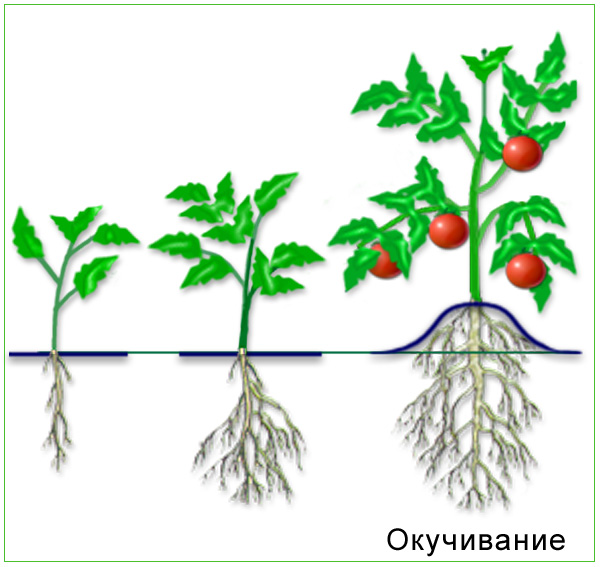
CRIB.
Source: http://www.hpora.ru/
Root - the underground part of the vegetative body of a plant, fixing it in the soil. Appeared for the first time in vascular plants.
Root functions:
1. Absorbing - water with substances dissolved in it is transferred through the xylem to the aboveground organs, where it is included in the processes of photosynthesis.
2. Conductive - water and nutrients move through the xylem and phloem of the root.
3. Storage - synthesized organic substances are returned from terrestrial organs to the root through the phloem and stored.
4. Synthetic - many amino acids, hormones, alkaloids, etc. are synthesized in the root.
5. Anchor - fix the plant in the ground.
In the root, the main root and lateral roots are distinguished. The primary root is laid down in the embryo, it is oriented downwards and becomes the main one in gymnosperms and flowering plants. Lateral roots form on the main one.
The root is an axial organ that has radial symmetry and grows in length indefinitely due to the activity of the apical (apical) meristem. It differs from the stem in that leaves never grow on it, and the apical meristem is covered with a cap. 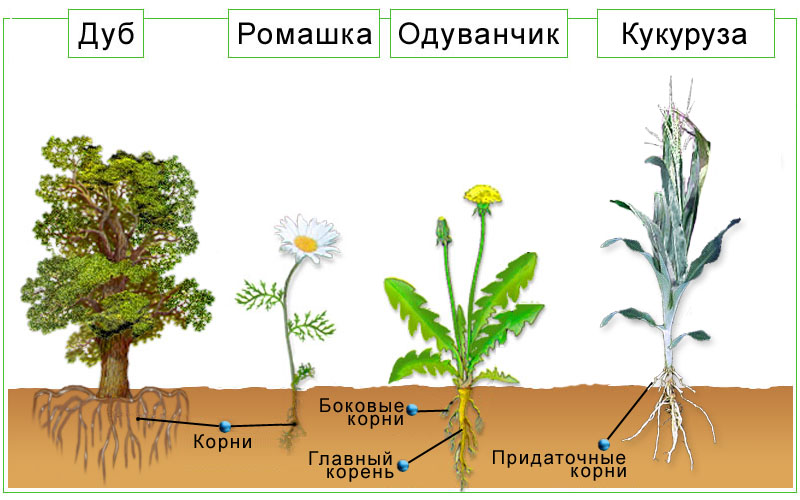
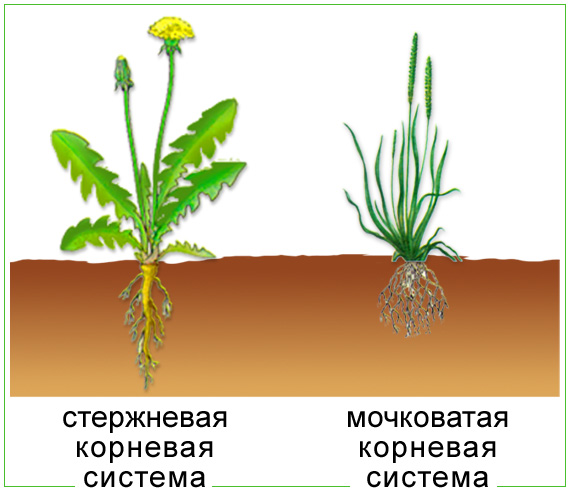
Types of root systems:
* Tap root system - includes the main and lateral roots, typical for dicotyledonous flowering and gymnosperms.
* Fibrous - formed from adventitious roots that grow from the bottom of the shoot.
Soil, its importance for plant life:
Soil is composed of solid particles derived from the parent rock, the type of which determines the mineral composition of the soil. The content of water in the soil is the main factor for the development of plants. Soils consisting of particles of different sizes are considered the most favorable for water retention. The living components of the soil (microorganisms, fungi, invertebrates and small vertebrates) improve soil fertility. So, nitrogen-fixing bacteria and blue-green algae enrich the soil with bound nitrogen, mycorrhiza-forming fungi stimulate the mineral nutrition of plants. The presence of organic residues in the soil, which are constantly exposed to mineralization by microorganisms and are a continuous source of soil nutrition, is very important. The more organic residues in the soil, the more fertile it is.
The internal structure of the root. The conducting system of the root (sieve tubes and vessels) is located radially in the center of the root, forming an axial cylinder by the cells of the main tissue. Through the vessels, water is transported with substances dissolved in it to the ground organs of the plant from the root hairs. Between the cords of the vessels are sieve tubes. They serve to transport organic solutions from the ground part of the plant to the root cells. Between the phloem and xylem there is an educational tissue - cambium, the cells of which are continuously dividing, ensuring the growth of the root in thickness. The absorption of water with substances dissolved in it is carried out in the zone of root hairs. The root hair is an outgrowth of the cell, it lives for about 20 days and is replaced by a new one.
Root zones on a longitudinal section:
1. Root cap:
2. Division zone - dividing cells of the educational tissue.
3. Growth zone - carries out the growth of the root in length.
4. Suction zone - located above the growth zone. Its surface is covered with outgrowths of outer cells - root hairs, which absorb water from the soil with substances dissolved in it. The root hairs are covered with mucus, which dissolves the mineral particles of the soil, and the roots adhere firmly to the substrate. Lateral roots are laid in this zone.
5. Conduction zone - in the center of the root there is a conductive tissue formed by wood (xylem) and bast (phloem). The area is characterized by constant growth. It accounts for most of the root length. Here the root thickens due to cell division of the cambium. In the zone of conduction, the root branches.
Root zones
|
Root zone |
Cell Features |
What tissue is formed |
Function |
|
root cap |
Cells are dead, easily mucus |
coverslip |
Protects against mechanical damage, mucus promotes the advancement of the root in the soil |
|
division zone |
Cells are small and constantly dividing |
educational |
Cells are constantly dividing, providing root growth |
|
growth zone |
Cells are young, grow, that is, lengthen |
educational |
The cells are stretched, due to them the root grows in length |
|
Suction zone |
The zone is represented by root hairs. The root hair is an elongated cell |
main suction |
Root hairs absorb mineral salts dissolved in water. |
|
Venue |
The zone is represented by vessels - these are dead cells |
conductive |
Through the vessels of the root, minerals dissolved in water move from bottom to top along the stem. |

Root modifications.
Roots. due to the strong growth of the parenchyma or due to the activity of additional layers of the cambium, the root thickens, it changes into a root crop. In radishes, beets and turnips, most of the root is formed by the overgrown base of the stem; in carrots, on the contrary, the main part of the root forms the main root. Root crops are adapted for storing nutrients.
Other modifications: root tubers (dahlia),
aerial roots (corn).
trailing roots (ivy)
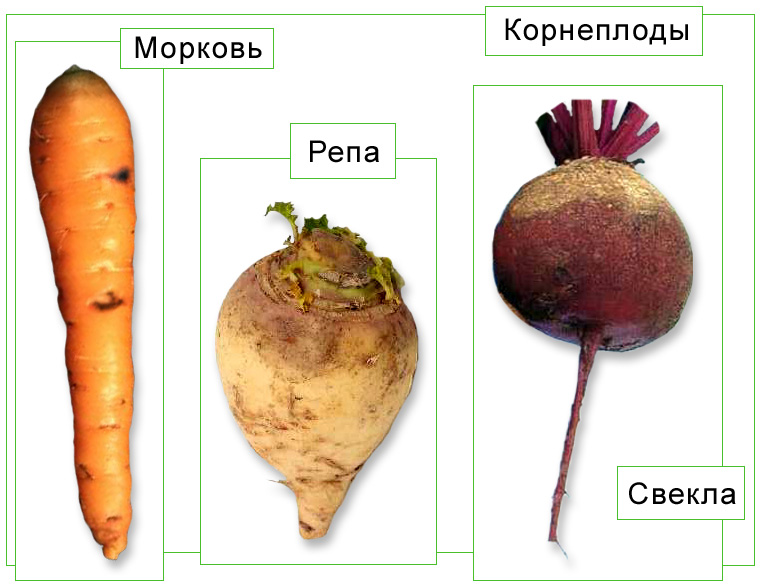
![]()
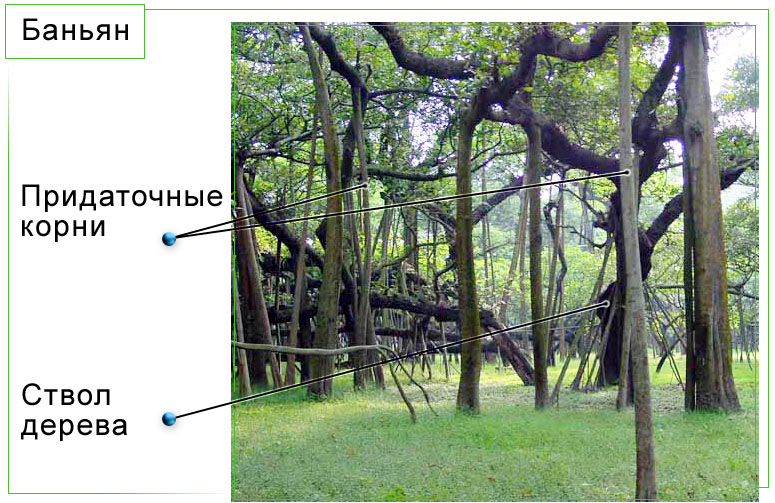
test questions
- What is a root?
- What is the function of the root?
- What are the types of roots?
- What is a root system?
- What types of root systems are isolated in monocot plants? dicot plants?
- What zones does the root consist of? What function does each of them perform?
- What is a root cap? Describe its functions and structural features.
- What modified roots do you know?
- What are the similarities and differences in the structure of the root of carrots, radishes and beets?







